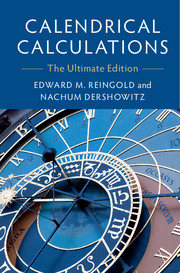Book contents
- Frontmatter
- Dedication
- Contents
- List of Frontispieces
- List of Figures
- List of Tables
- List of Calendar Functions
- Abbreviations
- Mathematical Notations
- Preface
- Credits
- License and Limited Warranty and Remedy
- 1 Calendar Basics
- I Arithmetical Calendars
- 2 The Gregorian Calendar
- 3 The Julian Calendar
- 4 The Coptic and Ethiopic Calendars
- 5 The ISO Calendar
- 6 The Icelandic Calendar
- 7 The Islamic Calendar
- 8 The Hebrew Calendar
- 9 The Ecclesiastical Calendars
- 10 The Old Hindu Calendars
- 11 The Mayan Calendars
- 12 The Balinese Pawukon Calendar
- 13 Generic Cyclical Calendars
- II Astronomical Calendars
- III Appendices
- References
10 - The Old Hindu Calendars
from I - Arithmetical Calendars
Published online by Cambridge University Press: 22 March 2018
- Frontmatter
- Dedication
- Contents
- List of Frontispieces
- List of Figures
- List of Tables
- List of Calendar Functions
- Abbreviations
- Mathematical Notations
- Preface
- Credits
- License and Limited Warranty and Remedy
- 1 Calendar Basics
- I Arithmetical Calendars
- 2 The Gregorian Calendar
- 3 The Julian Calendar
- 4 The Coptic and Ethiopic Calendars
- 5 The ISO Calendar
- 6 The Icelandic Calendar
- 7 The Islamic Calendar
- 8 The Hebrew Calendar
- 9 The Ecclesiastical Calendars
- 10 The Old Hindu Calendars
- 11 The Mayan Calendars
- 12 The Balinese Pawukon Calendar
- 13 Generic Cyclical Calendars
- II Astronomical Calendars
- III Appendices
- References
Summary
Scientists with advanced computers have sometimes failed to predict major earthquakes, but ancient Indian astrology does have the tools to roughly foretell the time and sometimes even the exact date and time of an earthquake.
Murli Manohar Joshi: The Irish Times (August 4, 2003)Structure and History
The Hindus have both solar and lunisolar calendars. In the Hindu lunisolar system, as in other lunisolar calendars, months follow the lunar cycle and are synchronized with the solar year by introducing occasional leap months. Unlike the Hebrew lunisolar calendar (described in Chapter 8), Hindu intercalated months do not follow a short cyclical pattern. Moreover, unlike other calendars, a day can be omitted any time in a lunar month.
Modern Hindu calendars are based on close approximations to the true times of the sun's entrance into the signs of the zodiac and of lunar conjunctions (new moons). Before about 1100 c.e., however, Hindu calendars used mean times. Though the basic structure of the calendar is similar for both systems, the mean (madhyama) and true (spas. t.a) calendars can differ by a few days or can be shifted by a month. In this chapter we implement the mean system, as described in [4, pp. 360-446], which is arithmetical; Chapter 20 is devoted to the more recent astronomical version. For an ancient description of Hindu astronomy, calendars, and holidays, see the book on India by al-Bīrūnī [1]; a more modern reference is [3].
There are various epochs that are, or have been, used as starting points for the enumeration of years in India. For a list of eras, see [5, pp. 39-47, civ-cvi]. In this chapter, we use the expired Kali Yuga (“Iron Age”) epoch. The expired year number is the number of years that have elapsed since the onset of the Kali Yuga. As van Wijk [6] explains:
We count the years of human life in expired years. A child of seven years has already lived more than seven years; but on the famous 18 Brumaire de l'An VIII de la République Française une et indivisible only 7 years and 47 days of the French Era had elapsed.
- Type
- Chapter
- Information
- Calendrical CalculationsThe Ultimate Edition, pp. 155 - 168Publisher: Cambridge University PressPrint publication year: 2018

